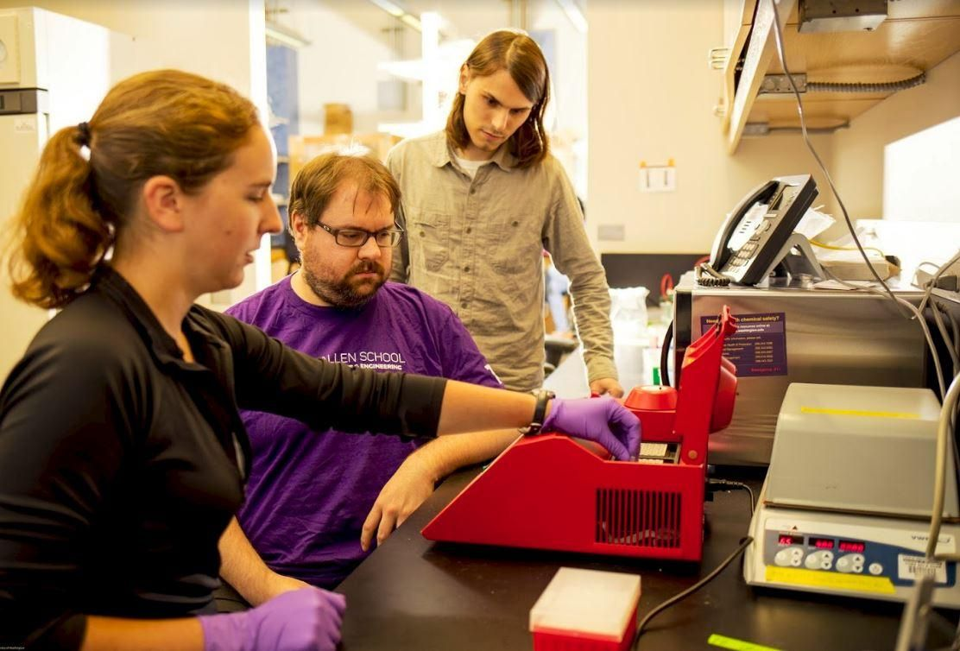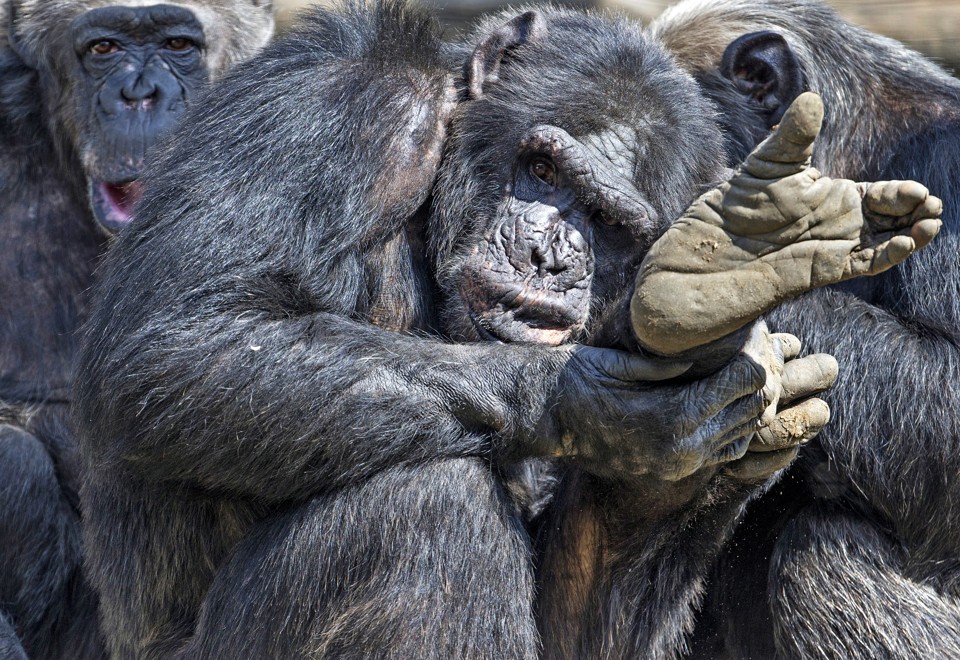The Ed's Up #196

A Dinosaur So Well Preserved, It Looks Like a Statue
"When we look at dinosaurs in museums, it takes imagination to plaster flesh and skin on top of the bones. But for the dinosaur that Funk unearthed—a 110-million-year-old creature named Borealopelta—imagination isn’t necessary. It looks like a sculpture. And based on pigments that still lurk within the skin, scientists think they know what colors the animal had. “If someone wants to come face to face with a dinosaur, and see what it actually looked like, this is the one for that,” says Caleb Brown from the Royal Tyrrell Museum, who has studied the animal." (Image: Royal Tyrell Museum)
The Designer Baby Era Is Not Upon Us
"One week ago, MIT Technology Review reported that scientists at an Oregon-based lab had modified the DNA of human embryos using the gene-editing technique known as CRISPR. That was a first for the United States; until then, such a procedure had only ever been done in China. But the full details of the experiment, which are released today, show that the study is scientifically important but much less of a social inflection point than has been suggested. “This has been widely reported as the dawn of the era of the designer baby, making it probably the fifth or sixth time people have reported that dawn,” says Alta Charo, an expert on law and bioethics at the University of Wisconsin-Madison. “And it’s not.”" (Image: OHSU) 
Meet Patagotitan, the Biggest Dinosaur Ever Found
"In 2013, an old Argentinian shepherd named Aureliano Hernandez found a fossilized bone protruding from a rock at the farm where he worked. The remains of giant dinosaurs festoon Argentina’s landscape, and knowing the strict rules that govern such fossils, the farm’s owners—the Mayo family—contacted local paleontologists. By the time the team arrived, Hernandez had passed away. He never knew that as one of his final acts, he had discovered the largest dinosaur ever known. The fossil he had found was so big that it took two weeks to unearth it. It was a thigh bone, and the largest ever found—eight feet from end to end. There are photos of paleontologists lying next to it for scale, and they look like bemused pixies, their bodies and imaginations dwarfed by what they had found." (Image: Shannon Stapleton)

These Scientists Took Over a Computer by Encoding Malware in DNA
"DNA is fundamentally a way of storing information. Usually, it encodes instructions for making living things—but it can be conscripted for other purposes. Scientists have used DNA to store books, recordings, GIFs, and even an Amazon gift card. And now, for the first time, researchers from the University of Washington have managed to take over a computer by encoding a malicious program in DNA."
How Humans Turned a Sea Snake to the Dark Side
"Most cases of industrial melanism involve moths, butterflies, and other insects, but Claire Goiran, from the University of New Caledonia, has now discovered a surprising exception. In the waters around Australia, one species of sea snake, which usually has black and white stripes, has also become completely black. And just like the peppered moths, urban pollution is probably to blame." (Image: Claire Goiran)
A Strange Type of Anthrax Is Killing Chimpanzees
"When chimps first started to drop dead in front of him, Fabian Leendertz had no idea why. “It’s normal for wildlife to hide their weakness until they can’t anymore,” he says. One minute he’d be running through the Taï forest in the Ivory Coast, tracking chimps who looked in the peak of health. The next minute, the animals would be lying down and breathing heavily. A few hours later, they were dead. Initially, Leendertz thought that the chimps had been floored by a virus like Ebola or measles. But after examining the bodies, he and his team identified a culprit that wasn’t even on his list of suspects: anthrax." (Image: Yves Herman)

Confirmed: Night Lights Drive Pollinators Away From Plants
"It’s hard enough to grab an insect during the day, so try doing it in the dark, while wearing night-vision goggles. These eyepieces offer little in the way of depth perception, and “catching insects without that is not easy,” says Eva Knop from the University of Bern. Nevertheless, she and her colleagues persisted, and became better with practice. Over several summer nights, they would head out into 14 Swiss meadows, half of which were illuminated by artificial lights, and half of which were kept in darkness. For several hours, the team would wander slowly through the fields, peering into local flowers, and catching every insect that they found. And their census, conducted over two consecutive summers, provides the first clear evidence that night-lighting deters or distracts pollinating insects. That, in turn, harms the plants they would typically visit. (Image: NASA)
Book news
I Contain Multitudes was shortlisted for the Royal Society Book Prize! And the book came out exactly a year ago this week.
More good reads: science and tech
- “To experience transcendence during a solar eclipse is a privilege of modernity.” Ross Andersen has an achingly beautiful essay on the upcoming eclipse. Meanwhile, Rebecca Boyle notes that the eclipse may be North America’s greatest mass migration to see a natural event, Marina Koren considers how blind people will experience the eclipse, Maggie Koerth-Baker looks at what happens to the solar grid during an eclipse.
- Journalists and psychiatrists need to stop armchair-diagnosing Trump, argues Christie Aschwanden. It’s more about politics than mental health.
- Why the Curiosity Rover stopped singing happy birthday to itself
- Furry Jurassic mammals, gliding over the heads of dinosaurs.
- 2016 was unprecedentedly hot and weird. Meanwhile, here’s how the Trump administration is following through on its plans to pull out of the Paris agreement.
- “This is the sort of thing that the fossil record loves to do to us.” On the curious skull of an infant ape that might or might not tell us about the common ancestor of all living apes.
- “Almost no one in Hiroshima recalls hearing any noise of the bomb.”
- What it’s like to draw blood from a whale shark.
- DNA from a 1,000-year-old illuminated manuscript could revolutionize the study of medieval books.
More good reads: politics and society
- Reverse racism is not a thing. Vann Newkirk II explains why, and why the myth is so persistent.
- Trump is currently engaged in a game of chicken with North Korea. The single best piece for context is this one from Mark Bowden analyzing America’s four terrible options for dealing with NK. Kori Schake writes about why loose words can lead to war, Eliot Cohen writes about why America is not ready for a war with NK, and David Graham considers why Trump is wholly unsuited to the North Korea crisis.
- “Bill.... Bill Murray? I thought it was you!” Bill Murray goes to see Groundhog Day: The Musical
- Robert Mueller, special counsel for the Russia investigation, directed FBI agents to raid the home of former campaign manager Paul Manafort, and has issued subpoenas through grand juries. “Both revelations indicate the investigation is entering advanced stages.”
- Don’t give HBO’s forthcoming show Confederate the benefit of doubt, argues Ta-Nehisi Coates.
- “The bedrock principles of American democracy are often more revered than actually believed.” ON the waning support for democracy, especially among young people.
- Trump gets a folder full of positive news about himself twice a day. It’s called “the propaganda document”.
- Despite the chaos and incompetence, Trump is still getting more stuff done than people imagine.
- "Nolan walks in the footsteps of both film directors and politicians who have chosen to whitewash the past." Why a lack of African and Indian faces in Dunkirk matters.
- And finally… The life and times of Whittaker, the turkey from the left turn lane. Delightful story by Julie Beck
And that's it. Thanks for reading.
- Ed